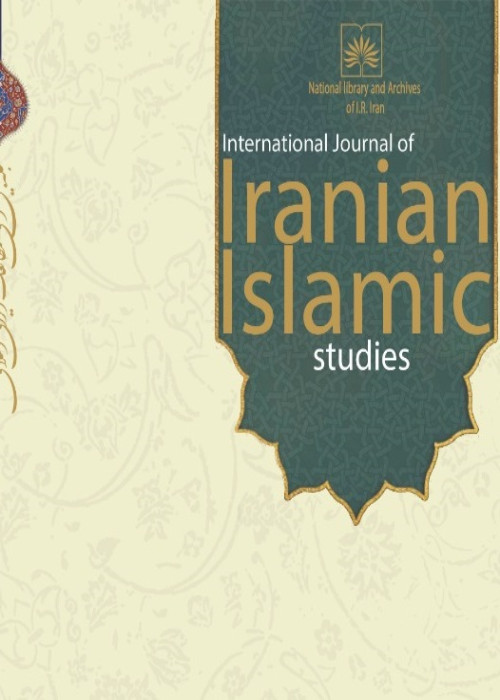Sassanid-Islamic Caravanserais of Southwest Iran: A Case Study (Mohammad Abad Caravanserai in Kohgiluyeh Region)
ding caravansaries has been one of the most important civil and welfare activities of Iranians during historical and islamic centuries. Although numerous researches have been done by former researchers, there are many untold things to clarify the changes of this form of architecture. In south of Iran (Khouzestan and Kohgiluyeh & Boyer Ahmad provinces) there are some caravansaries left from the last centuries. It is belived that the investigation of these structures helps the better understanding of changing trend of building caravansaries in Iran, especially in its southern parts. Among them, an old caravansary located in the vicinity of Mohammad Abad village, Dezhe-Mahtabi caravansary, KhanAvaz caravansary (in Kohgilouyeh & Boyer Ahmad province) , Darvazeh - Gach caravansary (located in Ramhormoz city in Khouzestan province), and many others in Lar region (Fars province) could be mentioned. The question which we are going to find its answer in this study is that: What is the most important charactristic of simple caravansaries in southwest of Iran and how has been the history and the evolution of them? The method used in this survey are descriptive-conformative and also historical-analytical approaches. While investigating historical resources about road connections in the region during islamic period and archeological evidence of Mohammad Abad caravansary, the authors have made an attempt to evaluate the similarity of this caravansary with other similar caravansaries in Kohgilouyeh & Boyer Ahmad, Khouzestan, Fars, and another similar building in western Qasr-alheir in Syria.In terms of plan and overall map, Mohammed Abad caravanserai is comparable to “Darvazegach” caravanserai which is known as the oldest caravanserai in Iran, belonging to the Sassanid period. However, in terms of overall dimensions, Mohammed Abad caravanserai is considered as a larger sample of “Darvazegach” caravanserai. Although it is comparable to Dezhmahtabi caravanserai in the fifth century AH/10th century CE in terms of the materials used, the type of arch (crescent arch), and the pillars applied, according to the list of stations on Arjan-Semirom route mentioned by Moghaddassi (the fourth century AH/10th centuries CE; the oldest historical text about the historical route of Arjan-Isfahan), the first station from Arjan is Kenesht Majoosan. It is possible that Dezhmahtabi caravanserai is the station mentioned by Moghaddassi. Since Mohammad Abad caravanserai is the second well-known caravanserai in Kohgiluyeh, which is about 2-day travel (60 km) from Arjan, it is the same station mentioned by Moghaddassi (Gharyeh is the second station on Arjan-Isfahan route). Thus, the construction of Mohammad Abad caravanserai can be attributed to at least the fourth century AH. Although it is not possible to neglect the presence of Dehdasht 10 km east of Mohammad Abad caravanserai, which was probably called the village of Al-Dasht initially and Dehdasht in the Safavid era with a significant position in the Kuhgiluyeh region, artifacts not older than Seljuqid period have been found there. It is noteworthy that the third station on this historical route is the city of Ziz in the 4th century AH/10th century CE, Ziz and Gharyeh stations were built simultaneously. Moghaddasi stated that Ziz was a small town located along the Taab River, where meat, walnuts, and fruits were cheap, and the central mosque, which began in 367 AH/ 977 CE, was left unfinished until 368 AH/978 CE when he was still there. Mohammad Abad caravanserai is also comparable to north and south Khan Avaz caravanserais on the Arjan-Shiraz route, which are attributed to the fourth and fifth centuries AH based on the study of surface potteries. It should be noted that during the fourth and fifth centuries AH/ 10th-11th centuries CE, Kohgiluyeh was part of Fars province, which was under the rule of Al-Bouye (327-432 AH/ 938-1040 CE); therefore, it is possible to attribute the construction of this caravanserai to Al-Bouye. It is said that “Azud Al-Dawla” constructed 3,000 mosques and inns in the late 4th century AH, mostly in western parts of Iran. Al-Bouye caravanserais in this region are probably part of the network of caravanserais built based on Al-Bouye caravan program. Mohammad Abad caravanserai was used by the tribes of the region during the Pahlavi era. The parts of the caravanserai restored with rock and mortar are related to this period. In the 1990s, as the city of Mohammad Abad emerged, the ceiling and walls of the caravanserai were extensively demolished and its gypsum was used for the construction of new houses. The simple architecture of these caravansaries, which had long spaces suitable for keeping the horses of the caravans, suggests a function beyond the accommodation of travelers and is probably rooted in “Chapar Khaneh” originating from the Achaemenid period. As we know, a number of caravanserais were the means of conducting “Barid” or dispatching political-official messages, that had maintained their importance from the Achaemenid period to the Islamic middle centuries. Barid was arranged on regular intervals at intermediate stop points and by changing horses, and in addition to delivering documents and messages quickly, it was an obvious means of transferring military and civilian information (ibid: 438). Barid in the south-west communication routes in Iran was more important than other parts of Iran, because the major capitals of Iran were in Fars from the Achaemenid period to the Al-Bouye period, and the important way connecting the western centers of the Persian empire from Shusha and Ctesiphon to the center of Fars passed from Khuzestan and Kohgiluyeh. What has been reported about this way in the Islamic era is the mention of places such as Farzuk, Bandak, Hebs, Khan Hammad, Jonbaz or Gonbad Molghan. Therefore, it is not beyond expectations that the form of these caravansaries would be the continuation of pre-Islamic monuments for Chapar Khanes which had the task of informing and conveying governmental documents to various parts of the empire. However, what does this form in the Western Qasr Al-Hayr collection indicate? As historical sources show, with the establishment of the Umayyad system in the middle of the first century AH and the reversal of the Islamic government towards the royal government and the proclamation of Muawiyah as the first king of the Arabs, he established Barid by consulting his Persian and Roman advisors in order to fulfill his goals in the administrative system of the government. He aimed to set up the Supreme Court to speed up the collection of news and information in the areas under management, secure the roads and counterespionage operations, repel the evil of bandits, care for and repair roads, bring Khalifa’s secret news to senior officials, and provide regular reports on financial, military, and civilian affairs and its dissemination. At the Umayyad era, Barid expenditure was forty million Dirhams, which is twice the amount spent by the next dynasty, the Abbasids. Koureh Arjan and Kohgilouyeh region, in the course of the Achaemenid and Sassanid dynasties, linked Asia Minor through Mesopotamia to Susa, Arjan, and Estakhr. The Silk Road also passed Baghdad, Halwan, and Nasibain and reached, after crossing the Euphrates, the city of Hierapolis and the port of Antioch on the Mediterranean coast. In the Islamic period, this region maintained its communication position through which the economic relationship of Fars was established with the centers of the Islamic caliphate in the Chamat in the Umayyad period (Syria and Jordan) and Iraq during the Abbasid period (Basra, Baghdad, and Al-Vaset), and an important commercial route passed from this region to Isfahan. Therefore, it is not beyond expectations to notice the formation and construction of this type of caravanserais in Syria during the Umayyad period.In this study, Mohammad Abad caravansary was investigated by using historical resources and archeological evidence and it has been illustrated that this caravansary and other similar caravansaries are dating back to Sasanid to Al-Booyeh era. The building lack any castle in corners, but the remained evidence suggests a guarding room on the top of their entrance. Curved roofs and similar dimensions of them are two others main charactristics of these buildings. The similar appearance of these caravansaries implies the existence of a coherent plan from road building authorities of Sasanid to Saljuqi period. If these structures are put in the texture of the regions which are under investigation, considering the fact that Darvazeh-Gach is attributed to Sasanid period, it would be probable that with the formation if Arjan city and its importance in the south of Iran, constructing caravansaries has been one of the most necessities of communication with other regions in Iran and with the five regions. And it should be mentioned that historians have noticed the importance of Arjan area in Al-Booyeh period. Transformation of the wealth acquired from agriculture and trade in this region, had resulted in paying attention to roads in Arjan region and to the construction of public facilities like caravansaries and numerous bridges which is recognized better by doing archeological investigations. Anyway, archeological evidence show that this caravansary has been built in Sasanid and Al-Booyeh periods. However, considering the fact that there has been no archeological study about the beneath parts of the building and probable adjoints, these kinds of studies seem necessary to investigate revolutionary trend of caravansaries located in south of Iran in details. These studies are also having a pivotal role in understanding questions about the reasons why these caravansaries are small and the reasons for not observing security principles in building them. In late islamic period, in which constructing caravansaries was very common, many of them has been built in Lar region in Fars province and demonstrates the continuation of this form of architecture in this period. Yet, these caravansaries are not like what researchers described them as four-porches buildings, and they lack any kind of Porch. The only porch in them might be their entrance part. The practical aspects of these building as stables in three sides of them, compared to low attention paid to providing rooms for passengers, make researchers to remember Chapar houses which were built in islamic period, specifically the early centuries, in accordance with Achaemenid innovations. Hence, the roads on which these buildings have been established (roads like Khouzestan to Fars), have had a great importance in Achaemenid to Sasanid period.
- حق عضویت دریافتی صرف حمایت از نشریات عضو و نگهداری، تکمیل و توسعه مگیران میشود.
- پرداخت حق اشتراک و دانلود مقالات اجازه بازنشر آن در سایر رسانههای چاپی و دیجیتال را به کاربر نمیدهد.




